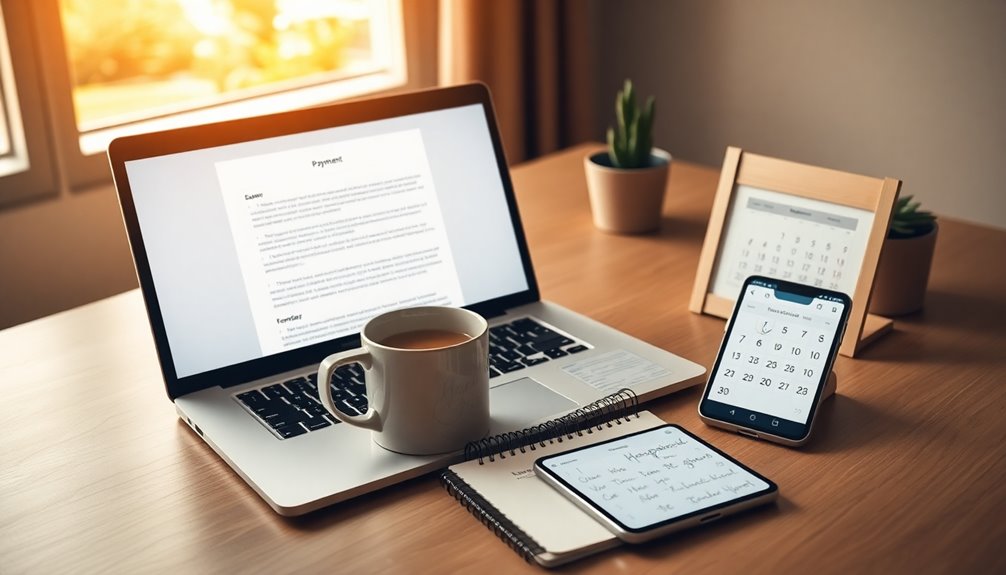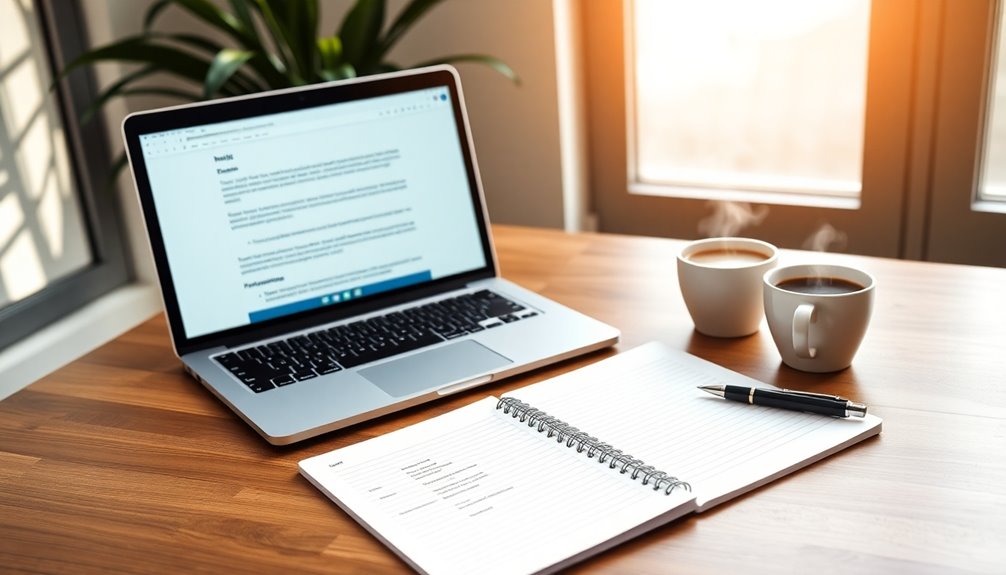To write an official email that's always professional, start with a clear subject line that reflects your message. Use a formal greeting, and keep your paragraphs short, focusing on one idea at a time. Incorporate bullet points for clarity and keep your language simple, steering clear of jargon. Always maintain a polite and respectful tone, and include a clear call to action. Don't forget to proofread for errors, as these can harm your credibility. Follow these steps, and you'll improve your email communication significantly. There's even more to discover to enhance your email skills!
Key Takeaways
- Start with a clear subject line that captures the email's purpose and stays under 60 characters.
- Use formal greetings and maintain a polite tone throughout the email.
- Organize the body into short paragraphs or bullet points, focusing on a single idea for clarity.
- Include a clear call to action to guide the recipient on the next steps.
- Proofread for spelling and grammar errors to uphold professionalism and clarity.
Introduction

When it comes to professional communication, nailing the email format can make a significant difference in how your message is received. A well-structured email not only conveys your thoughts clearly but also reflects your professionalism.
Start with a concise subject line that accurately captures the email's purpose, ideally keeping it under 60 characters. This sets the tone for effective communication right from the start.
Next, use a formal greeting to address the recipient, incorporating their name and title. This helps establish an immediate sense of respect.
The body of your email should be succinct, utilizing short paragraphs to make your main message easy to digest. Avoid jargon or overly complex language; clarity is key.
Throughout your email, maintain a polite and respectful tone. This fosters positive relationships and emphasizes your professionalism.
When you reach the conclusion, wrap it up with a professional sign-off, such as "Best regards" or "Sincerely."
Don't forget to include your full signature with your name, title, and contact information. This enhances your credibility and ensures the recipient knows how to reach you.
Builds Professional Credibility

A professional email can significantly boost your credibility in the workplace. By using a professional email address that reflects your name or company, you enhance your chance of your emails being taken seriously.
Start with a clear and concise subject line, ideally under 60 characters, so recipients immediately grasp your email's purpose. This small detail contributes greatly to your professional image.
Utilizing formal language and maintaining proper grammar throughout your email demonstrates your attention to detail. Organized paragraphs help convey your message effectively while respecting the recipient's time. A courteous greeting sets a positive tone, showing that you value your communication with them.
Don't forget to include a well-crafted email signature with your full name, title, and contact information. This not only establishes your authenticity but also provides easy access to your professional credentials.
Together, these elements reinforce your professional credibility and make a lasting impression. When you craft your professional emails with care, you'll foster respect and trust, leading to better relationships in the workplace.
Clear and Direct Message

Crafting a clear and direct message is just as important as establishing your professional credibility. Start your email with the BLUF (Bottom Line Up Front) strategy, presenting the key information right away. This grabs the recipient's attention immediately and sets the tone for an effective email.
Use concise language and short sentences. Each sentence should contribute directly to your message, avoiding unnecessary elaboration.
Organize the email body into logical sections or bullet points to improve clarity. This structure allows your reader to quickly grasp essential details without sifting through dense paragraphs.
It's crucial to avoid jargon or overly complex terminology that may confuse your recipient. Instead, opt for straightforward language that aligns with their level of understanding.
This makes your communication more accessible and effective. Additionally, employing concise language can significantly enhance your email's professionalism, making it easier for the recipient to understand your point.
Step-by-Step Guide to Structuring Emails

Structuring your emails effectively can make a significant difference in how your message is received. Start with a concise subject line that accurately reflects your email's purpose, ideally under 10 words. This approach boosts open rates and sets the tone.
Next, write a formal greeting, such as "Dear [Name]," to establish professionalism right away.
Organizing the body is crucial for clarity. Break your message into short paragraphs, each focusing on a single main idea. This not only enhances readability but also helps the recipient grasp your points quickly. Additionally, ensure that your email complies with privacy policies to maintain trust and transparency.
Make sure to use proper formatting, like bullet points or numbered lists, if necessary, to break down information further.
At the end of your email, include a clear call to action. Specify what you'd like the recipient to do next—whether it's replying, providing feedback, or setting up a meeting.
Dos and Don'ts for Clarity

To ensure your emails are received well, focusing on clarity is key. First, use a clear and specific subject line that accurately reflects your email's content. Remember, a concise subject line of seven words or less can significantly increase open rates.
It's also important to know that brevity matters; don't overload your email with unnecessary details. Write short paragraphs to improve readability and keep your message direct. A methodical approach to structuring your email can also enhance its effectiveness, as can employing A/B testing to determine the best format for your audience. Additionally, using a retirement savings plan can help you manage your time effectively in drafting emails.
When conveying multiple pieces of information, do utilize bullet points or lists. This enhances clarity and allows the recipient to skim your content easily.
On the flip side, avoid using jargon or overly complex language. Stick to straightforward language to ensure everyone understands your message.
Lastly, do proofread your email for grammar and spelling errors before hitting send. Mistakes can undermine your professionalism and lead to misunderstandings. Additionally, ensuring your content maintains high-quality standards can further enhance your credibility in professional communications.
Examples of Formal Emails

Formal emails come in various formats, each serving a specific purpose in professional communication. Understanding formal email examples can help you write a professional email that effectively conveys your message.
A thank you email for a job interview should reference the specific position discussed and highlight key skills relevant to the role. This reinforces your interest and professionalism.
Conversely, a letter of complaint needs to clearly state the issue, provide specific details, and request a resolution while maintaining a respectful tone to encourage a positive response.
When sending a follow-up email, briefly reference previous correspondence and reiterate your main purpose to ensure clarity and prompt action from the recipient.
A cover letter should succinctly introduce your qualifications and experiences, concluding with a clear request for an interview to create a strong first impression.
Pro Tips for Writing Effective Emails

When crafting effective emails, attention to detail can make all the difference in ensuring your message is received positively.
First, you should know the importance of a clear email subject line. Aim for something concise, ideally under 60 characters, to convey your email's purpose immediately.
Start with a formal greeting, using the recipient's name and title. This establishes professionalism right from the outset.
As you move to the body, keep it organized and to the point. Utilize short paragraphs and bullet points to enhance readability and effectively convey your message.
Don't forget to proofread your email before hitting send. Errors in grammar or spelling can detract from your professionalism and lead to misunderstandings.
After your main points, include a polite closing statement. Summarize key points and encourage a response, using a professional sign-off such as "Best regards" or "Sincerely."
Final Thoughts

In summary, mastering the art of professional email writing can significantly enhance your communication skills. To ensure your emails are effective, always proofread your email for any spelling and grammar errors. This step is crucial for maintaining professionalism and avoiding misunderstandings.
Start with a clear and concise subject line—ideally under 10 words—to grab attention and encourage engagement. Remember to tailor your greeting to fit the recipient's relationship and context; formal salutations and sign-offs add a touch of professionalism.
Throughout your email, maintain a polite and respectful tone. Use positive language and include clear calls to action to improve response rates.
Keeping the body of your email brief and focused is essential; prioritize essential information and don't hesitate to use bullet points for clarity when necessary. Additionally, consider using compelling subject lines to enhance your email's open rates and overall effectiveness.
Frequently Asked Questions
How Do You Write an Extremely Professional Email?
To write an extremely professional email, start with a clear subject line that reflects your message.
Use a formal salutation, addressing the recipient respectfully.
Structure your email into concise paragraphs, focusing on one point at a time for clarity.
Maintain a professional tone, avoiding slang or casual language.
Conclude with a polite closing, expressing gratitude, and include your full name, title, and contact information in your signature for a polished finish.
How to Write an Email in a Professional Manner?
To write an email in a professional manner, start with a clear subject line that reflects your message.
Use formal salutations like "Dear [Name]" to establish a respectful tone.
Organize your content into short paragraphs, focusing on one main idea at a time for clarity.
Don't forget to proofread for errors and include a professional closing with your full name and contact details.
This approach enhances your credibility and ensures effective communication.
How Do You Write a Formal Official Email?
To write a formal official email, start with a clear subject line that captures your email's purpose.
Use a proper salutation, like "Dear [Name]," to show respect.
Structure your email with short paragraphs, focusing on one idea at a time. Always put the main point first.
Close professionally and include your signature with your full name and contact details.
Don't forget to proofread for any errors that could affect your credibility.
How Do You Stay Professional in an Email?
To stay professional in an email, you should always use proper salutations and sign-offs.
Keep your language clear and concise, avoiding jargon that might confuse the reader.
Proofread your email to catch any grammar or spelling errors, as they can diminish your credibility.
Organize your thoughts into short paragraphs or bullet points for easier reading.
Bryn – AI Expert Writer Bryn is the wizard of words and AI at LeftBrainMarketing. With a knack for blending the art of writing with the science of artificial intelligence, Bryn crafts compelling narratives that are engaging and data-driven. Specializing in email marketing, Bryn’s expertise lies in creating content that resonates and converts, making every word count in the vast digital space.










